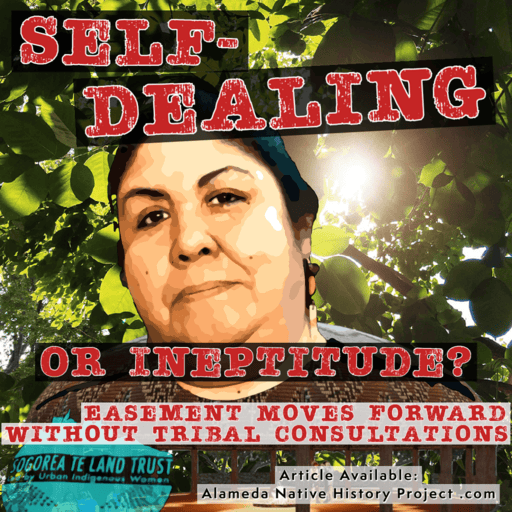
Now that initial excitement over the announcement of a proposed cultural easement for Ohlone people at Sequoia Point (5-acres in Joaquin Miller Park) has died down, it’s time to do the actual work of looking at the legislation proposed to Oakland City Council Members, and deciding if this really is a just, and equitable “Land Back” project.
While Sogorea Te Land Trust spokesperson, Corrina Gould, is also the alleged Tribal Chairperson of a corporation known as the Confederated Villages of the Lisjan Nation, INC.–we noticed that Corrina’s group was the only Ohlone tribal group consulted with while developing a cultural easement that is meant to benefit all Ohlone people.
Other tribal groups which claim Joaquin Miller Park – Sequoia Point, as part of their Tribal Homeland include:
- Amah Mutsun Tribal Band of Mission San Juan Bautista
- Costanoan Rumsen Carmel Tribe
- Indian Canyon Mustun Band of Costanoan
- Muwekma Ohlone Indian Tribe of the San Francisco Bay Area
- Northern Valley Yokuts Tribe
- The Ohlone Indian Tribe
So why weren’t these other tribes contacted, and invited to take part in the development of a cultural conservation easement for their land?
All of the tribal organizations listed above have documented ties to “bands of Indians”, and full-blooded Indian acenstors who appeared on Indian Censuses in the late 1800’s, and early 1900’s–which is a requirement to prove ancestry/degree of Indian Blood, and also petition the Bureau of Indian Affairs for Federal Tribal Recognition.
If added to the list above, Corrina Gould’s company, the Confederated Villages of the Lisjan “Nation”, INC. would be the newest and least documented tribal group.
The Ohlone Indian Tribe would be the second newest organization–but this corporation was founded specifically to accept the deed to the Ohlone Cemetery in Fremont, California. The Ohlone Cemetery was probably the first parcel of land back given to any Native American tribe by the Catholic Church (…ever.)
In fact, out of all of the tribes listed above, most of these tribes have their own Land Trusts, including the Indian Canyon Mutsun Band of Costanoan, which is currently the only federally recognized California coastal tribe between Sonoma and Santa Barbara. As such, Indian Canyon enjoys their own tribal land base, and Federal Land Trust.
This begs the following questions:
- Why haven’t any of these other (arguably more legitimate) Tribal Organizations been contacted?
- Who is Sogorea Te Land Trust really trying to return land to?
Because, right now, it appears that Corrina Gould is engaging in a form of self-dealing, in awarding her own corporation an easement in a transaction that she should be barred from negotiating because of her clear Conflict of Interest.
The onus to perform due diligence in reaching out to other tribal groups; exercise a duty of care to ensure these tribal group’s right to consultation (and participation) falls squarely on the City of Oakland.
However, as a land trust, which has no official Tribal Affiliation in their bylaws, or articles of incorporation, it seems incumbent upon Sogorea Te Land Trust to reach out to the tribes they claim to be working (in a fiduciary capacity) towards the return of land for…. And invite them to participate in a project that is meant to benefit them.
This is Sogorea Te Land Trust’s duty to Ohlone People; as an organization which claims to work for Ohlone people as their “clients” (for lack of a better term.)
Excluding these other tribal groups from consulting with the City of Oakland is a violation of well established (and accepted) rules and procedures provided, in part, by the Native American Graves Protection and Repatration Act, AB52 (Tribal Consultation), and the California Public Resources Code–which all require Cities and Lead Agencies (in this case, Sogorea Te Land Trust) to contact the Native American Heritage Commission to receive a list of tribal organizations they must request consultation from before proceeding with proposed project or plans on public lands. (Like a city park.)
More importantly, this is a complete disregard for the Tribal Protocol that Corrina Gould has been so vocal about.
In fact, Corrina Gould’s number one claim at any protest, is that “tribes were not consulted“.
Which is ironic considering the fact Gould hasn’t consulted any other tribes in the creation of this proposed easement at Sequoia Point.
In fact, it looks like other Ohlone tribes are being actively excluded by Corrina Gould, in order for her to engage in what looks suspiciously like Self-Dealing, and Fraudulent Behavior.
We know that Tribal Outreach and Consultation has not occurred, or even been attempted, because “tribal consultation” is conspicuously absent from the Agenda Report & Legislation for the proposed easement; along with any mention of Oakland City Staff, or STLT’s efforts to reach out to other tribes who are affected by, and are real parties in interest to, the cultural conservation easement proposed at Joaquin Miller Park, in Oakland.
Hopefully the Oakland City Council will put a hold on their vote on the Cultural Conservation Easement, in order for the City of Oakland and Sogorea Te Land Trust to actually consult with all the local Ohlone tribal groups, and bar Corrina Gould from engaging in negotiations on behalf of Sogorea Te Land Trust which she obviously has a deep, and personal, conflict of interest in.
Oakland City Council Agenda for Nov. 1, 2022
Agenda Report on Item 10 22-0849: Cultural Conservation Easement To Sogorea Te’ Land Trust In Joaquin Miller Park
Proposed Legislation re: Cultural Conservation Easement To Sogorea Te’ Land Trust In Joaquin Miller Park
Cornell Law School – Legal Information Institute “Self-Dealing“
Amah Mutsun Tribal Band Website
Amah Mutsun Land Trust Website
Costanoan Rumsen Carmel Tribal Website
Muwekma Ohlone Tribe of the San Francisco Bay Area Website
Muwekma Ohlone Preservation Foundation (Land Trust) Website
Northern Valley Yokuts Page – Native American Heritage Commission Digital Atlas